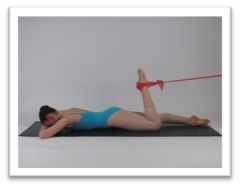A strained muscle, how to recognise and treat …
by Sally Harrison, Perfect Form Physio
 A strained muscle is a very common injury amongst those with a highly active life. Although our muscles can withstand a lot of physical demands sometimes if the muscle is overloaded and unable to manage the stresses placed upon it may tear. This is what is known as a strain.
A strained muscle is a very common injury amongst those with a highly active life. Although our muscles can withstand a lot of physical demands sometimes if the muscle is overloaded and unable to manage the stresses placed upon it may tear. This is what is known as a strain.
Muscle strains are classified into 3 grades:
Grade 1: Small number of fibres damaged, local pain and no loss of strength
Grade 2: Significant tear, pain and swelling, pain on contraction of muscle, decreased strength and movement limited by pain
Grade 3: Complete tear, often where the muscle joins the tendon. Not much pain, but loss of function is seen.
Muscles that cross 2 joints, and therefore under more load are at increased risk of muscle strain. The hamstrings and gastrocnemius (calf) are examples .
WHY DOES IT HAPPEN?
It is important to ascertain why the muscle was torn in the first place. A muscle strain may occur due to the following factors:
- Reduced flexibility for the required task. Simply, there is not enough length and elasticity in the muscle and the fibres tear.
- Increased tone/tightness. This also leads to reduced elasticity and is often seen in a muscle that is over chronically working and shortened.
- Fatigue or decreased endurance/stamina. This leads to a weaker muscle for the power demands of an exercise. We may then land poorly or execute with poor technique leading to injury.
- Muscle imbalance.
- Poor warm-up technique. Again the muscle will be less elastic.
- Decreased eccentric strength. Eccentric strength is required for deceleration / landing from jumps and controlling high kicks. This type of strength is essential.
- Faulty technique and movement patterns. This can lead to direct injury or lead to chronic over working of a muscle.
SYMPTOMS
A muscle strain is usually felt at the time of incident and may be perceived as a crack /pop or ripping feeling. There is often immediate pain and if the tear is bad, swelling and bruising may occur quickly. The degree of damage will determine if the area can be moved easily. For example it may be difficult to walk after a calf or hamstring tear.
TREATMENT
Management of a Grade 3 injury (i.e. a complete tear) often requires surgical intervention and specialised post-surgery rehabilitation.
In all other cases injury management will include:
1. Decreasing swelling, bleeding and pain with ‘RICE’ –
- Relative rest (pain free movement)
- Ice
- Compression (tubigrip or bandage)
- Elevation
NOTE: RICE should be in place for the first 24 hours
2. After the initial 24-48 hour period, MICE should now be in place –
- Movement (includes gentle movement throughout range – pain free)
- Ice (as swelling persists)
- Compression
- Elevation (often a good idea towards the end of the day)
3. Increase range of motion (ROM) and strength
It is important to regain full, pain free ROM early. Early strength can be maintained by performing isometric contractions (where the muscle works with no actual movement). This is then followed with high repetition, low load exercises. This stage of exercises will be guided and progressed by your physiotherapist so that the correct pacing and introduction of functional rehabilitation can progress. It is important not to start dancing/doing sport too early and re-rupture the area.
RECOVERY
Recovery will normally take about 3-6 weeks but can be longer for bad tears.
It is important to include eccentric strength training in the recovery programme to avoid further tears in the future.
PREVENTION
- Adequate warm up and cool down every time
- Good flexibility and symmetry in the body left to right
- Good technique to avoid undue strain on the muscles
- Control within the movement and controlled landings
- Avoid dancing ‘full out ‘when very fatigued
- Good nutrition and hydration to keep the tissues healthy at a base level.





















